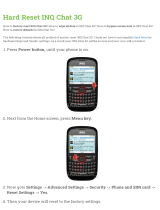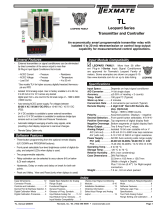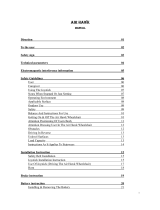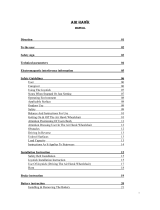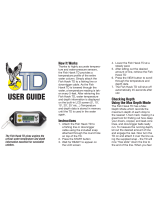Page is loading ...

Hawk 3
H335 and H345
3 1/2 Digit and 4 1/2 Digit
Advanced Digital Controller
Operator’s Manual

This instrument is designed to prevent accidental shock to the operator when properly used. However,
no engineering design can render safe an instrument which is used carelessly. Therefore, this manual
must be read carefully and completely before making any measurements. Failure to follow directions
can result in a serious or fatal accident.
Technical Assistance
SIMPSON ELECTRIC COMPANY offers assistance Monday through Friday 8:00 am to 4:30 pm Central
Time by contacting Technical Support or Customer Service at (715) 588-3311.
Internet: http://www.simpsonelectric.com
Warranty and Returns
SIMPSON ELECTRIC COMPANY warrants each instrument and other articles manufactured by it to
be free from defects in material and workmanship under normal use and service, its obligation under
this warranty being limited to making good at its factory or other article of equipment which shall within
one (2) year after delivery of such instrument or other article of equipment to the original purchaser be
returned intact to it, or to one of its authorized service centers, with transportation charges prepaid, and
which its examination shall disclose to its satisfaction to have been thus defective; this warranty being
expressly in lieu of all other warranties expressed or implied and of all other obligations or liabilities on
its part, and SIMPSON ELECTRIC COMPANY neither assumes nor authorizes any other persons to
assume for it any other liability in connection with the sales of its products.
This warranty shall not apply to any instrument or other article of equipment which shall have been
repaired or altered outside the SIMPSON ELECTRIC COMPANY factory or authorized service centers,
nor which has been subject to misuse, negligence or accident, incorrect wiring by others, or installation
or use not in accord with instructions furnished by the manufacturer.
About this Manual
To the best of our knowledge and at the time written, the information contained in this document is
technically correct and the procedures accurate and adequate to operate this instrument in compliance
Notes and Safety Information
This Operator’s Manual contains warning headings that alert the user to check for hazardous
the safety of operating performance of this instrument, these instructions must be adhered to.
Warning, refer to accompanying documents.
Attention, consulter les documents d’accompagnement.
Caution, risk of electric shock.
Attention, risque de choc électrique.
2

Contents
Quick Start Reference for Typical Control Instrument Features 5
Installation and Wiring 5
Programming 5
Basic Key Operation for Programming 5
Decimal Point 5
Linearization 6
Set Points & Relays 6
1. INTRODUCTION 8
1.1 General Description 8
1.2
8
2. INSTALLATION AND PANEL CUTOUT 10
2.1 Mounting Requirements 10
2.2 Engineering Label Placement 10
2.3 Removing / Installing Modules 11
3. INPUT CARDS 11
3.1 Low Current 11
3.2 High Current 12
3.3 Volts 13
3.4 Resistance 14
3.5 Relay Cards 14
3.6 Power Supply Cards 15
4. OUTPUT CARDS 15
4.1 Excitation 16
5. DISPLAY AND KEYPAD CONTROLS 17
5.1 Operating the Keys 17
5.1.1 Run Mode 17
5.1.2 Program Mode 17
5.1.3 Edit Mode 17
5.1.4 Reset to Factory Defaults 17
5.1.5 Password Reset 17
3

Contents (Con’t)
6. PROGRAMMING 18
6.1 Programming Order 18
6.2 General Programming Guidelines 18
6.3 Programming Menu 18
6.4 Setpoint and Relay Control 19
6.4.1 Setpoint Values 19
6.4.2 Relay Settings 19
6.5 Display Control 21
6.6 Measurement Control 22
6.7 Output Control 23
6.7.1 Setting the Limits (LIM) 23
6.8 Scaling / Linearization Control 25
6.8.1 Linearization Detail 26
6.9 Password 28
6.9.1 Password Entry 29
6.9.2 Changing the Password 29
7. RS-485 COMMUNICATIONS 29
7.1 RS-485 Command Structure 29
7.2
29
7.3 Address 29
7.4 Valid Commands 30
7.5 Examples 32
8. FLOW CHART 34
9. ORDERING INFORMATION 37
4

QUICK START REFERENCE FOR TYPICAL
CONTROL INSTRUMENT FEATURES
This section outlines the most commonly used features of the Hawk 3 controller
and functions as a quick start guide. Please refer to the table of contents to find
in-depth information or advanced features.
Installation and Wiring
See Section 1 in this manual for specific wiring and installation information per-
taining to user’s specific unit. With only the power supply wired, the Hawk 3 can
be programmed before installation. The Hawk 3 features non-volatile memory;
programming information will not be lost due to power loss or when changing
meter’s location.
Programming
Many of the advanced features of the Hawk 3 respond to, and interact with, each
other. When programming the Hawk 3 it is important that the proper order is fol-
lowed when setting up features. The following is the recommended order.
1. Decimal Point
2. Linearization (AKA Scaling)
3. Set Point/Relay Control (if applicable)
4. Analog output or other applicable controls.
Basic Key Operation (for Programming)
1. enters the main programming menu, backs out of submenus (one level at a
time) and returns to run mode from the main menu. Exiting the programming
menu in this manner assures that all changes will be saved.
also moves
the cursor to the left.
2.
scrolls through menus and changes parameters.
3. RES opens submenus, moves a blinking parameter into edit mode and allows
editing.
Decimal Point
Using the 3-1/2 digital Hawk 3 as an example, the decimal point can be placed
in any one of 5 locations without affecting the number. For example, 10 volts will
display as 10.00. This display can be changed to get 100.0. Keep in mind that the
decimal point is still needed for some applications.
1. Press
to enter the programming mode.
2. Scroll
until “G&W/”(display control) shows. Press
3. When “G3” and “
” flashes, press
.
4. “
” is now a fixed display. Use or to move the decimal point as neces-
sary. Press
5. Use
to save changes.
5
.
.

Linearization
Using a Hawk 3 3-1/2 digits meter with a 200mVDC range, the following example shows 2 pt.
linearization for 150DCA application using a 50mV shunt.
Please refer to Section 6.8.1 for multiple point linearizations and in-depth instruction.
1. Press
"
to enter programming mode.
2. Scroll
until “ 6&W/” (screen control) displays.
3. Press “/LQ” (linearization) should display.
RESET
ENTER
.
7. Use appropriate
,
or
buttons to change the numbers as follows. If necessary, move
cursor one place to the left of “2” to remove the “-” sign. (See page 5, Basic Key Operations)
(/( = 0.0, G63 = 0.0, (/( = 50.0 and G63 = 150.0
8. Use
to save changes. You may need to press the left arrow several times till "X3GW)/6+"
shows on the meter.
Now 150.0 is on the display with 50.0DCmV applied to the input.
Set Points & Relays
CAUTION: Before editing the set points and relays check that the
decimal point and linearization are set properly.
RESET
ENTER
RESET
ENTER
RESET
ENTER
RESET
ENTER
1. Press
to enter programming mode.
2. Scroll
or
until the appropriate menu item (63– 63 ) displays. Press .
Press .
4. Set number to the desired value by using
,
or
. Press .
Press . Use
or
to select choice: Delay, Latch or Hysterisis.
Only one response can be set.
a. Delay: This parameter will actuate the given relay after a set amount of time
when past the set point setting. Press .
The display will show “GB/R” and a number. Press .
i. Use
,
or
to enter the amount of delay time (0-60 Sec).
ii. Press
RESET
ENTER
. The display will show “GB+L” and a number.
iii. Press
RESET
ENTER
. Enter the amount of delay time (0-60 Sec). Press .
RESET
ENTER
RESET
ENTER
RESET
ENTER
RESET
ENTER
RESET
ENTER
RESET
ENTER
RESET
ENTER
6
R)) ” and “ &RUG ” (coordinate).
R))
3W
(/(
9$/
U63
G/$<

b. Latch: This parameter will actuate the given relay. To reset manually,
press .
i. The display will flash between “/W&+ ” and a number. Press ent .
ii. Enter the amount of delay desired before the relay actuates. (0-60
Seconds) Press ENT .
c. Hysterisis: This is the percentage above or below the setpoint where
the
relay will actuate.
i. The display will show “+B/R ” and a number. Press .
ii. Enter the % of hysterisis (0-29.9%) falling Edge, Press .
iii. The display will show “+B+L ” and a number. Press .
iv. Enter the % of hysterisis (0-29.9%) rising Edge. Press .
6. To set alarm to “Hi”, “Lo” or “Off ”, press when display flashes
Choose “Hi”, “Lo” or “Off” and press .
7. Next choose the state of the relay to be Normally Energized “Q(” or
De-Ener-gized “QG ”. When display flashes press . Choose desired state
Press to return to main menu.
8. Set SP2, SP3 and SP4 as necessary and save changes.
7

1. INTRODUCTION
The Simpson Electric Hawk 3 Advanced Digital Panel Meter/Controller has both 3-1/2 and
4-1/2 digit displays. All LEDs are 7 segment and offer 5 brightness levels.
This high quality instrument has user-programmable parameters, all set from the front panel in
easy to understand terminology. The display shows activated set point indicators (up to four).
The keypad buttons have both audible and tactile feedback to prevent keystroke errors.
1.1 General Description
DISPLAY
Type 7- segment, red LED, 4 or 5 digits
Height 0.56” (14.2mm)
Brightness 5 settings, user programmable
Decimal Point 4 or 5 position, user programmable
Overrange Indication
(Example: H335)
Underrange Indication
Alarm Indicators 4 LED indicators for up to four independent setpoints
Linearization H335 has a 2 points
H345 has a 16 points
POWER REQUIREMENTS
AC 85 to 250 VAC or 120VAC @ 10VA
DC 9 to 36 DCV @ 10VA
Isolation 250V RMS MAX
Note: Each supply is shown at the maximum and minimum values except the 120 VAC unit, which is allowed
± 10%
ENVIRONMENTAL
Operating Temperature 0 to 50ºC
Storage Temperature -10 to +60°C
Relative Humidity < 80% for the temp. up to 31ºC and decreasing linearly to 50% relative
humidity at 50°C
Ambient Temp 25°C
Temperature Drift ± 100 ppm /°C
Warmup time 10 minutes
NOISE REJECTION
NMRR 60 dB @ 50-60 Hz
CMRR 70 db @ 50-60 Hz
Note: For indoor use to an altitude up to 200m
ANALOG TO DIGITAL CONVERSION
Technique Successive approximation with oversampling
Sample Rate 10 conversions per second
Display Rate User Programmable from 1 - 420 updates / minute (240 default)
8

RS-485 Specications (only available on H345)
2 wire / Half duplex, Baud rate: 9600 baud, 1ms delay per character, 32 Nodes Maximum on Bus. Opti-
cally and magnetically isolated for ground loop elimination
MECHANICAL
Bezel 3.92” x 2.0” x 0.52” (99.8mm x 51.9mm x 132mm)
Depth 3.24” (82.3mm) behind panel
Panel cutout 3.62” x 1.77” (92mm x 45mm) 1/8 DIN
Weight 10 oz. (283.5 g)
Cover NEMA 4X Rated front panel
ELECTRICAL
Accuracy Listed as % of reading at 25°C. Add 100ppm/°C to compensate for drift.
Tested at 50Hz, include +/-1 count for every 100Hz above 50 Hz
Transient Overvoltage Installation Category III, Pollution Degree 2
Analog Output
Sampling Rate = 100 mSec. Reaction TLPHWR)XOO6FDOH ȝ6HF
Table 1 - 1
Input Board
Type Range
Resolution
4-1/2
Resolution
3-1/2
Input
Impedance Overload
Accuracy
4-1/2
Accuracy
3-1/2
DC
Voltage
Vm002 10 ȝV .1 mV 1M 5 DCV ± .05% of reading ± 1 count ± .1% of reading ± 1 count
V2 .1 mV 1 mV 1M 5 DCV ± .05% of reading ± 1 count ± .1% of reading ± 1 count
20 V 1 mV 10 mV 1M 300 DCV ± .05% of reading ± 1 count ± .1% of reading ± 1 count
200 V 10 mV .1 V 1M 300 DCV ± .05% of reading ± 1 count ± .1% of reading ± 1 count
600 V .1 V 1 V 1M 1K DCV ± .1% of reading ± 1 count ± .2% of reading ± 1 count
Table 1 - 3
Input Board
Type Range
Resolution
4-1/2
Resolution
3-1/2
Input
Impedance Overload
Accuracy
4-1/2
Accuracy
3-1/2
AC Voltage
(Same for
TRMS
* @ 60 Hz)
Vm002 10 ȝV .1 mV 200K 5 DCV ± .05% of reading ± 1 count ± .1% of reading ± 1 count
V2 .1 mV 1 mV 200K 5 DCV ± .05% of reading ± 1 count ± .1% of reading ± 1 count
20 V 1 mV 10 mV 1M 300 DCV ± .05% of reading ± 1 count ± .1% of reading ± 1 count
200 V 10 mV .1 V 1M 300 DCV ± .05% of reading ± 1 count ± .1% of reading ± 1 count
600 V .1 V 1 V 1M 1K DCV ± .1% of reading ± 1 count ± .2% of reading ± 1 count
Table 1 - 2
Input Board
Type Range
Resolution
4-1/2
Resolution
3-1/2
Input
Impedance Overload
Accuracy
4-1/2
Accuracy
3-1/2
DC
Current
200 ȝA 10 nA .1 ȝA1K 4.5 mA DC ± .05% of reading ± 1 count ± .1% of reading ± 1 count
Am2.1 ȝA1 ȝA 100 45 mA DC ± .05% of reading ± 1 count ± .1% of reading ± 1 count
20 mA 1 ȝA 10 ȝA 10 200 mA DC ± .05% of reading ± 1 count ± .1% of reading ± 1 count
200 mA 10 ȝA .1 mA 1 600 mA DC ± .05% of reading ± 1 count ± .1% of reading ± 1 count
2 A .1 mA 1 mA .013 5.5 A DC ± .2% of reading ± 1 count ± .3% of reading ± 1 count
5 A 1 mA 10 mA .013 5.5 A DC ± .2% of reading ± 1 count ± .3% of reading ± 1 count
Table 1 - 4
Input Board
Type Range
Resolution
4-1/2
Resolution
3-1/2
Input
Impedance Overload
Accuracy
4-1/2
Accuracy
3-1/2
AC Current
(Same for
TRMS
* @ 60 Hz)
200 ȝA 10 nA .1 ȝA 1K 4.5 mA DC ± .1% of reading ± 1 count ± .2% of reading ± 2 count
Am2.1 ȝA1 ȝA 100 45 mA DC ± 1% of reading ± 2 count ± .2% of reading ± 2 count
20 mA 1 ȝA 10 ȝA 10 200 mA DC ± .1% of reading ± 2 count ± .2% of reading ± 2 count
200 mA 10 ȝA .1 mA 1 600 mA DC ± .1% of reading ± 2 count ± .2% of reading ± 2 count
2 A .1 mA 1 mA .013 5.5 A DC ± .2% of reading ± 2 count ± .3% of reading ± 2 count
5 A 1 mA 10 mA .013 5.5 A DC ± .2% of reading ± 2 count ± .3% of reading ± 2 count
9

,167$//$7,21$1'3$1(/&87287
(QJLQHHULQJ/DEHO3ODFHPHQW
0RXQWLQJ5HTXLUHPHQWV
7DEOH
,QSXW%RDUG
7\SH 5DQJH
5HVROXWLRQ
5HVROXWLRQ
,QSXW
,PSHGDQFH
2YHUORDG
$FFXUDF\
$FFXUDF\
5HVLVWDQFH
P . '&9 RIUHDGLQJFRXQW RIUHDGLQJFRXQW
. . '&9 RIUHDGLQJFRXQW RIUHDGLQJFRXQW
. . '&9 RIUHDGLQJFRXQW RIUHDGLQJFRXQW
. 0 '&9 RIUHDGLQJFRXQW RIUHDGLQJFRXQW
1RWH7506VLJQDOVEHORZRIIXOOVFDOHPD\EHFRPHXQVWDEOHEHFDXVHRI7506SURFHVV
(QJLQHHULQJ/DEHO
0RXQWLQJ5HTXLUHPHQWV
7KH+DZN$GYDQFHG'LJLWDO&RQWUROOHU',1PHWHUVUHTXLUHDSDQHOFXWRXWRI´PPKLJKE\´
PPZLGH7RLQVWDOOWKHPHWHULQWRDSDQHOFXWRXWUHPRYHWKHFOLSVIURPWKHVLGHRIWKHPHWHU
6OLGHWKHPHWHUWKURXJKWKHSDQHOFXWRXWWKHQVOLGHWKHPRXQWLQJFOLSVEDFNRQWKHPHWHU3UHVVHYHQO\WR
(QJLQHHULQJ/DEHO3ODFHPHQW
7RUHSODFHWKHHQJLQHHULQJXQLWODEHOSODFHWKHWLSRIDEDOOSRLQWSHQLQWRWKHVPDOOKROHDWWKHEDVHRIWKH
HQJLQHHULQJODEHOLQWKHEH]HO
6OLGHWKHODEHOXSXQWLOLWSRSVRXW*UDVSDQGUHPRYH6OLGHWKHQHZODEHOKDOIWKHGLVWDQFHLQWKHQXVHWKH
EDOOSRLQWSHQWRVOLGHLWGRZQLQWRSODFH
)LJXUH,QVWDOODWLRQDQG3DQHO&XWRXW

2.3 Removing / Installing Modules
1. Remove module from case by inserting a screwdriver into tab slot opening on top of the
module. Apply pressure to release module from case. Repeat procedure for tab located on
underside of the module and slide the module away from the case.
2. To install a module, carefully align the module edges with the slots in the case and press
forward until the tabs (on top and bottom) engage.
NOTE:
calibration.
Shut power off before removing or installing modules.
Couper le courant avant de retirer ou d’installer des modules.
Figure 2.2. Removing Option Module
AC/TRMS Current:
microamp (200A) full scale up to 200 milliamp (200mA) full scale.
Because the signals measured may be less than the noise in the surrounding
environment, a shielded cable should be used with the signal source end
connected to earth ground.
Figure 3.1
3. INPUT CARDS
3.1 Low Current
WARNING: With this and all input cards, do not exceed 250
Vrms between “IN LO” and earth ground.
ATTENTION: Avec cela et toutes les cartes d’entrée, ne pas
dépasser 250 Veff entre “IN LO” et la terre.
AC MILLIAMPS
Range
~IN HI
200ȝA
~IN LO
20mA
200mA
2mA
11

DC Current:
RSHUDWHDWPLFURDPSȝ$IXOOVFDOHRUXSWRPLOOLDPSP$
IXOOVFDOH%HFDXVHWKHVLJQDOVPHDVXUHGPD\EHOHVVWKDQWKHQRLVHLQWKH
VXUURXQGLQJHQYLURQPHQWLWLVUHFRPPHQGHGWKDWDVKLHOGHGFDEOHEHXVHG
ZLWKWKHVLJQDOVRXUFHHQGFRQQHFWHGWRHDUWKJURXQG
7KHSRODULW\LVLPSRUWDQWIRUWKH'&FDUGWRRSHUDWHSURSHUO\&RQQHFWWKH
PRVWSRVLWLYH³´VLJQDOWRWKH³IN HI´WHUPLQDODQGPRVWQHJDWLYH³±´WRWKH
³IN LO´WHUPLQDO
AC/TRMS Current:
RSHUDWHDWDPS$IXOOVFDOHXSRUDPS$IXOOVFDOH%HFDXVHORQJOHQJWKV
DQGVPDOOZLUHFDQFDXVHORVVHVWRWKHVLJQDOPHDVXUHGLWLVUHFRPPHQGHGWKDW
ZLUHOHQJWKVDUHNHSWOHVVWKDQIHHWDQGZLUHEHQROHVVWKDQJDXJH
WARNING: With this and all input cards, do not exceed
250 Vrms between “IN LO” and earth ground.
ATTENTION: Avec cela et toutes les cartes d’entrée, ne
pas dépasser 250 Veff entre “IN LO” et la terre.
3.2 High Current
WARNING: With this and all input cards, do not exceed 250
Vrms between “IN LO” and earth ground. Use isolation
transformers or donut current transformers to monitor high
voltage equipment.
ATTENTION: Avec cela et toutes les cartes d’entrée, ne
pas dépasser 250 Veff entre “IN LO” et la terre. Utilisez des
transformateurs d’isolement ou beignet transformateurs de
courant pour surveiller les équipements haute tension.
WARNING: With this and all input cards, do not exceed 250
Vrms between “IN LO” and earth ground. Use isolation
transformers or donut current transformers to monitor high
voltage equipment.
ATTENTION: Avec cela et toutes les cartes d’entrée, ne
pas dépasser 250 Veff entre “IN LO” et la terre. Utilisez des
transformateurs d’isolement ou beignet transformateurs de
courant pour surveiller les équipements haute tension.
DC Current:
DWDPS$IXOOVFDOHXSRUDPS$IXOOVFDOH%HFDXVHORQJOHQJWKVDQG
VPDOOZLUHFDQFDXVHORVVHVWRWKHVLJQDOPHDVXUHGLWLVUHFRPPHQGHGWKDWZLUH
OHQJWKVDUHNHSWOHVVWKDQIHHWDQGZLUHEHQROHVVWKDQJDXJH
7KHSRODULW\LVLPSRUWDQWIRUWKH'&FDUGWRRSHUDWHSURSHUO\&RQQHFWWKH
PRVWSRVLWLYH³´VLJQDOWRWKH³IN HI´WHUPLQDODQGPRVWQHJDWLYH³±´WRWKH
³IN LO´WHUPLQDO
Figure 3.2
DC MILLIAMPS
Range
IN HI
200ȝA
IN LO
20mA
200mA
2mA
Figure 3.3
AC AMPS
Range
~IN HI
~IN LO
5A
2A
Figure 3.4
DC AMPS
Range
~IN HI
~IN LO
5A
2A

AC /TRMS Volts:
to operate at 200 millivolt (200 mV) full scale or up to 600 Volts (600V)
IN HI” is one of two
IN
HI” connection closest to “IN LO”.
IN HI”
connection farthest away from “IN LO” (Top of card).
each range.
3.3 Volts
DC Volts:
at 200 millivolt (200 mV) full scale or up to 600 Volts (600V) full scale.
IN HI” is one of two terminals. If
IN HI” connection
closest to “IN LO
volts, use the “IN HI” connection farthest away from “IN LO” (Top of card).
The polarity is important for the DC card to operate properly. Connect the
most positive “+” signal to the “IN HI” terminal and most negative “–“ to the
“IN LO” terminal.
WARNING: With this and all input cards, do not exceed 250 Vrms between
“IN LO” and earth ground. Connect “IN LO” to neutral line or use isolation
transformers to monitor high voltage equipment.
ATTENTION: Avec cela et toutes les cartes d’entrée, ne pas dépasser
250 Veff entre “IN LO” et la terre. Connectez “IN LO” à la ligne neutre ou
utiliser des transformateurs d’isolement pour surveiller l’équipement de
haute tension.
Damage and serious injury will occur if connection instructions for input cards are not
followed.
If the operating range of any input card needs changed, please contact a factory authorized
service center.
Dommages et des blessures graves se produire si les instructions de connexion pour les
cartes d’entrée ne sont pas respectées.
Si la plage de fonctionnement de tous les besoins de la carte d’entrée a changé, s’il vous
plaît contacter un centre de service autorisé de l’usine.
WARNING: With this and all input cards, do not exceed 250 Vrms between
“IN LO” and earth ground. Connect “IN LO” to neutral line or use isolation
transformers to monitor high voltage equipment.
ATTENTION: Avec cela et toutes les cartes d’entrée, ne pas dépasser
250 Veff entre “IN LO” et la terre. Connectez “IN LO” à la ligne neutre ou
utiliser des transformateurs d’isolement pour surveiller l’équipement de
haute tension.
Figure 3.5
>2V
2V Max.
AC VOLTS
~IN HI
20V/200V
600V
~IN HI
200mV/2V
~IN LO
Figure 3.6
>2V
2V Max.
DC VOLTS
IN HI
20V/200V
600V
IN HI
200mV/2V
IN LO
13

ohm (20K) and 200,000 ohm (200K) from the factory.
Use the ‘Tare’ feature to remove resistance offset created by lead length. Short
the remote resistor end and ‘Tare’, this will re-zero the input and cancel lead
length resistance. The card provides a DC signal to measure the resistance
input accurately.
3.4 Resistance
Do not apply any external voltage or current to this card; damage
will occur.
Ne pas appliquer de tension ou de courant à cette carte externe;
des dommages.
3.5 Relay Cards
The relay cards are directly related to any alarms that occur on the Hawk 3. The single relay is a
“Form C” (SPDT) relay that activates in relationship to
“SP1”.
The dual relay consists of two Form C” (SPDT) relays that activate in relationship to “SP1” & “SP2”.
The quad relay consists of four “Form A” (SPST) relays that activate in relationship to “SP1” through
“SP4”.
WARNING/CAUTION: “SP3” and “SP4” connections share a common.
All relay contacts are rated at 250 VAC @ 5 amp maximum. The rating of the relay contact
is intended for resistive circuits only. Use a snubber circuit to protect the contacts from
inductive loads.
AVERTISSEMENT / ATTENTION: “SP3” et connexions “SP4” partagent une
commune.
Tous les contacts de relais sont évalués à 250 VAC @ 5 ampères maximum. La
note du contact de relais est destiné uniquement aux circuits résistifs. Utiliser un
circuit de protection pour protéger les contacts à partir de charges inductives.
Figure 3.10
Quad Relay
Figure 3.8
Single Relay
5A
N.C.
COM
N.O.
1
250V~
RELAY OUT
Figure 3.9
Dual Relay
5A
N.C.
COM
N.O.
1
250V~
RELAY OUT
N.C.
COM
N.O.
2
250V~
5A
RELAY OUT
COM
N.O.
1
COM
N.O.
2
N.O.
COM
3
N.O.
4
Figure 3.7
RESISTANCE
Range
IN HI
IN LO
200
2k
20k
200k
14

The AC power cards operate from standard 50/60 Hz line power. The polarity for connecting
AC power (IN
˜
) is unimportant. The unit operates either way. The DC to DC power card is an
isolated supply that operates between 9 and 36 volts DC.
The “Hold” feature is used to freeze the display. When the contacts are shorted, the display will
“Hold” the last reading until short is removed. It is recommended that a mechanical switch or
relay be used to activate the hold circuit; solid state relays may give unexpected results. The
hold circuit cannot be externally powered.
An external fuse is required for safe operation. For AC supply, use a Slow Blow fuse at .25A,
Littlefuse Part No. 313.250 or equal. For DC supply use a Slow Blow fuse at 1.25A, Littlefuse
Part No. 3131.25 or equal. Fuse only one input.
CAUTION: Hazardous voltages may be present. Disconnect power before
making or removing connections.
Des tensions dangereuses peuvent être présentes. Coupez l’alimentation
électrique avant d’effectuer ou de retirer les connexions.
The 4-20mA output card will generate an isolated output between 4mA and
20mA that is related to the input level. This relationship can be set using the
menu. Linearization will also affect the relation. The factory default is when
the input is at its lowest level, the output is 4mA. When the input is at the
maximum rated input, the output is at 20mA.
Figure 4.1
4-20mA
3.6 Power Supply Cards
4. OUTPUT CARDS
Figure 3.11
120 VAC Supply
IN ~
120VAC
50/60 Hz
10VA
Hold
IN
~
Figure 3.12
Universal AC Supply
IN ~
85-250VAC
50/60 Hz
10VA
Hold
IN
~
Figure 3.13
DC to DC Supply
9 - 36 VDC
Hold
+
10W
4-20mA
+
MAX
-
15

The 0-10VDC output card will generate an isolated output between 0VDC and
10VDC that is related to the input level. This relationship can be set using the
menu.
Linearization will also affect the relation. The factory default is when the input
is at its lowest level the output is 0VDC. When the input is at the maximum
rated input the output is at 10VDC.
The Excitation output card provides a factory set isolated DC voltage of either 12VDC or 24VDC. The
maximum output current for the 12VDC is 30mA and 20mA for the 24VDC. Excitation is available alone
or can be included with the other outputs.
4.1 Excitation
The RS-485 card is used for communication in a network where multiple
sensors (not necessarily those of Hawk 3) report back to a central host
computer.
, half
duplex serial communication, and will respond on a polled basis only. Each
Hawk 3 will respond to it’s own unique address only after being requested by
the host. The Hawk 3 remains a listener until asked to respond. (See section
7 of this manual for further details about using the RS-485 card.)
Figure 4.2 0 - 10VDC
Figure 4.3 RS-845
+
300mA MAX
-
0 - 10V
+
-
RS-485
(A)
(B)
EXCITATION
24V, 20mA
+
-
12V, 30mA
Figure 4.4
EXCITATION
24V, 20mA
+
-
12V, 30mA
Figure 4.5
+
0$;
-
4-20mA
EXCITATION
24V, 20mA
+
-
12V, 30mA
Figure 4.6
+
300mA MAX
-
0 - 10V
EXCITATION
24V, 20mA
+
-
12V, 30mA
Figure 4.7
+
(A)
-
RS-485
(B)
16

5. DISPLAY AND KEYPAD CONTROLS
5.1 Operating the Keys
5.1.1 Run Mode
"
= Enters the Program Menu
= Displays the Maximum Value (if enabled). Press
and hold while pressing
to clear maximum value.
= Displays Minimum Value (if enabled). Press
and hold while pressing
to clear minimum value.
= Resets Latched Relays (If any).
and
= Sets Zero/Tare Value (if enabled). Also clears Minimum and Maxi mum values.
5.1.2 Program Mode
"
= Enters the Edit Mode. Flashing cursor shows value to edit (Numeric Val ues only).
= Scrolls “UP” through menu.
= Scrolls “DOWN” through menu.
= Selects a menu or submenu to edit.
5.1.3 Edit Mode
"
= Moves Edit Cursor to the left. Flashing cursor shows value to edit (Numeric Values Only).
= Increases Numeric Value or Scrolls “UP” through submenu.
= Decreases Numeric Value or Scrolls “DOWN” through submenu.
5.1.4 Reset to Factory Defaults
Simultaneously press
"
and
5.1.5 Password Reset
Simultaneously press
Numeric and Message
Alarm Status Indicators
Units Window
4-Button Keypad
RESET
ENTER
RESET
ENTER
RESET
ENTER
RESET
ENTER
RESET
ENTER
RESET
ENTER
17

6. PROGRAMMING
6.1 Programming Order
The following parameter order is recommended to change the display from the
default values. Parameters entered in any other order may cause unexpected
results.
G3- Always change the decimal point location first, to the desired display range. The
decimal point will then be in the proper position for setting setpoints or linearization.
Magnifying the display from 10 to 100 is as simple as moving the decimal point.
/LQ- Linearization affects the setpoints and analog-out results. If decimal point
location is changed, it will display in the wrong place for electrical input, but in the
desired location for output display.
The setpoints follow the displayed results of any linearization or decimal
point settings and not necessarily the electrical input.
$RX7 - The analog-out “Hi and Lo” settings also track the display results from the
above changes and not the electrical input.
6.2 General Programming Guidelines
Changes can be made while programming, unless the outputs or relay alarms are
critical to operation.
1. Press
to move in and out of the main programming.
2. Press
or to scroll to desired submenu. Press REs to enter a submenu.
Press
to scroll back to main menu.
3. To change a flashing parameter press REs and press
, or . To save
the
change and proceed to the next change, press .
NOTE: ALWAYS SAVE CHANGES! Improperly saved changes will be lost if
power fails.
4. Press REs after making the last change, then return to run mode by pressing
while in main menu mode. “XSGW)/6+” will display before displaying run
mode.
6.3 Programming Menu
Available menu choices depend on the operator’s password rights. Use caution
when changing values “on the fly” because relay changes are immediate upon
exiting menus. While in local menu, RS-485 communications will halt to avoid
command conflict. When in local or remote menu, relay and alarm operations are
suspended. If left in menu mode the local or remote menu will “time out” in two
minutes then resume normal operation.
18
VS - -

6.4 Setpoint and Relay Control
The followng relates to setting the setpoints 1 thru 4 (if available).
63>@ 9$O>@
Value
UVS
(Response)
+\VW+L
+\VW/R
0* to 29.9
percent
GO$\+L
GO$\/R
0* to 60.00 seconds
/W&+
0* to 60.00 seconds
$OU (Alarm) +LB*
/RB
RII
* Factory Reset Default Values
Table 6-1
6.4.1 Setpoint Values
The Hawk 3 can be purchased with up to 4 separate relay control setpoints (SP1
– SP4). Each setpoint needs to be individually programmed and can be set to a
value that corresponds to a programmed display range. To set control setpoints
press
to enter programming mode.
1. Scroll
or until the appropriate menu item “
63 – 63
” displays. Press
REs .
2. The display should flash between “
9$/
” (Value) and a number. Press .
3. Set this number to the desired value by using
, or . Press .
NOTE: While in programming menu, all other operations are suspended.
6.4.2 Relay Settings
Once the relay control setpoints are programmed, the display will flash alternately
from “
G/$<
” to “
U63
”. Press
REs to stop display flashing. Relay responses can
now be set. Use
or to select choice: Delay, Hysteresis or Latch.
NOTE: Only one response type can be set.
1. Delay: This is the amount of time the process has to be out of spec before
the relay actuates.
a. The display will show “
GB/R
” and a number. Press REs .
b. Enter the amount of delay Lo (Falling edge) time (0-60 Sec) value by using
, or . Press RES .
c. The display will show “
GB+L
” and a number. Press RES .
d. Enter the amount of delay Hi (Rising edge) time (0-60 Sec) by using
,
or . Press REs .
19

2. Hysteresis: This is the percentage above or below the setpoint where the relay
actuates.
a. The display shows “
+B/R
” and a number. Press REs .
b. Enter the % of hysteresis (0-29.9%) falling Edge by using
, or . Press
REs .
c. The display shows “
+B+L
” and a number. Press REs .
d. Enter the % of hysteresis (0-29.9%) rising Edge by using
, or . Press
REs .
3. Latch: This parameter sets the given relay in activation even after the alarm
condition has been removed. To reset the relay press REs .
a. The display will flash between “
/W&+
” and a number. Press REs .
b. Enter the amount of delay desired before the relay actuates (0-60 Sec-
onds) by using
, or . Press REs .
4. Alarm: The unit now flashes alternately between “
$OU
” and “
+,
”. The alarm
condition can now be set to either above the setpoint (HI), below the setpoint
“
/R
” or “
R))
”. To set alarm to “
+,
”, “
/R
” or “
R))
”, press REs when display
flashes. Choose “
+,
”, “
/R
” or “
R))
” by using or . Press REs .
5. State: Choose the desired relay state, Normally Energized “
Q(
” or De-Ener
gized “
QG
” when the unit is not in alarm. The unit will flash alternately between
“
6W
” and “
QG
”. Press REs . Choose either “
Q(
” or “
QG
” by using or . Press
REs .
6. Press to return to main menu.
7. Set SP2, SP3 and SP4 as necessary and save changes.
Relay Card/State
and Alarm Settings Single Double Quad
De-Energized no
alarm
NC-Com
connected
NC-Com
connected
NO-Com disconnected
De-Energized in
alarm
NO-Com
connected
NO-Com
connected
NO-Com connected
Energized no alarm
NO-Com
connected
NO-Com
connected
NO-Com connected
Energized in alarm
NC-Com
connected
NC-Com
connected
NO-Com disconnected
Table 6-2
Relation between State, Alarm and Type of Relay Card Chart
This chart shows the relationship between the Alarm and State settings and the
type of relay card used.
NC = Normally closed terminal
NO = Normally opened terminal
Com = Common terminal
20
/

